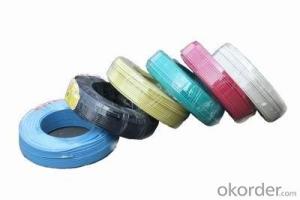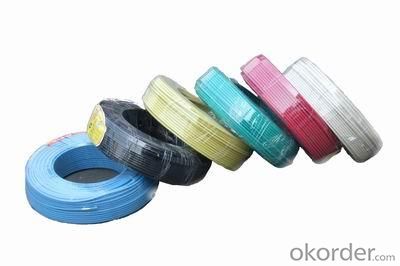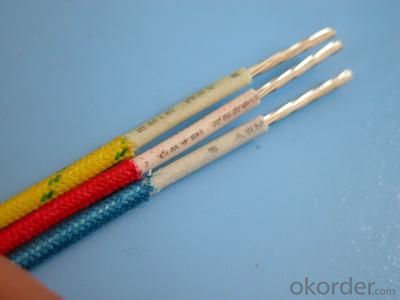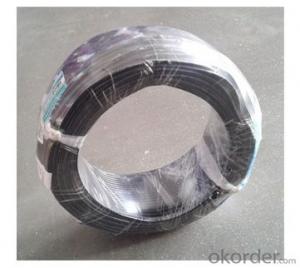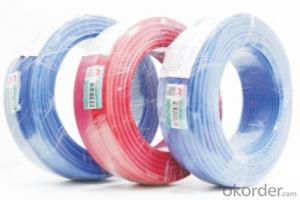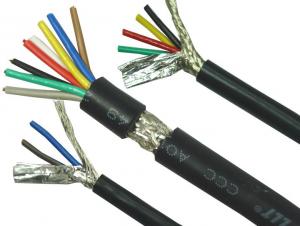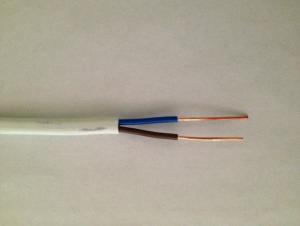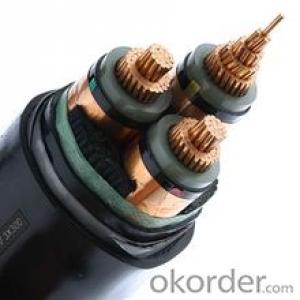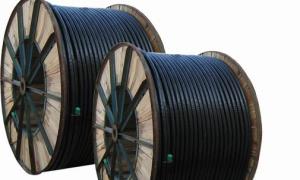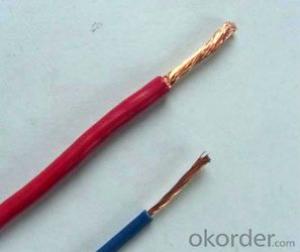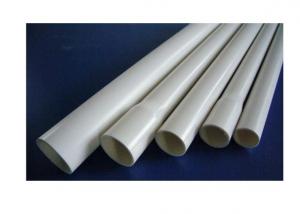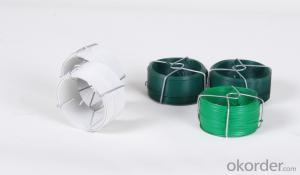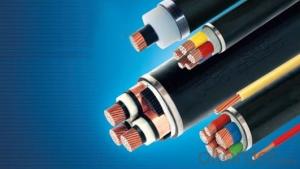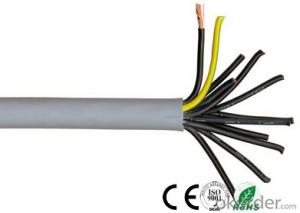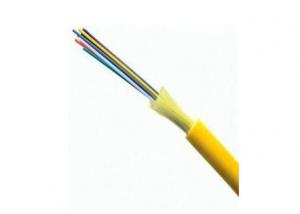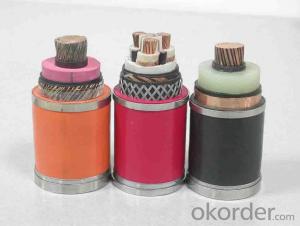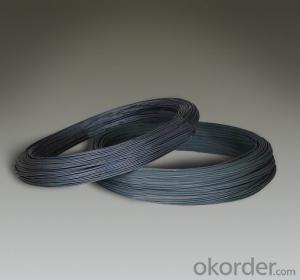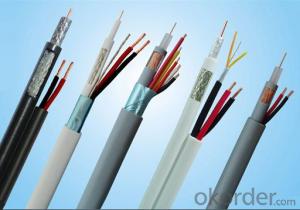Bcopper PVC Electrical Wire
- Loading Port:
- China Main Port
- Payment Terms:
- TT or LC
- Min Order Qty:
- -
- Supply Capability:
- -
OKorder Service Pledge
OKorder Financial Service
You Might Also Like
1. Product Description:
1). The rated voltage of the electrical wire should equal to or higher then the rated voltage of the system when wires are used at AC system. If the wires are used at DC system, the rated voltage of system should lower then 1.5 times as high as rated voltage of cable and wires. The working voltage of the system could be 1.1 times as high as the rated voltage of the cable.
2). The long term working temperature should lower then 70oC. The working temperature of BV-90 should lower then 90oC. And the laying temperature should higher then 0oC.
3). The curve diameter of the wire should longer than 8 times of the diameter of the outer diameter of cable and wires if their outer diameter is 25 mm or above. If the diameter of cable and wires is above 25 mm, the curve diameter should be at least 12 times of the outer diameter of the cable and wires.
2. Product Characteristic:
Type: InsulatedModel Number: BV,BVVB
Application: Indoors
Conductor Material: Copper
Conductor Type: Stranded
Insulation Material: PVC
Electrical wire
1.450/750V stranded copper core
2. PVC insulated
3. ISO CCC IEC standard
4. factory direct sales
This electrical wire is suitable for fixed laying in power plant with AC rated voltage up to and including 450/750V.
3.Specification:
Type | Name | Laying place and requirement | Long term working Temperature0C |
60227IEC01 05 BV BLV | Copper conductor PVC insulated wires Aluminum conductor PVC insulated wires | Fixed laid indoors Conduit etc. | 70 |
60227IEC07 (BV-90) | Heat resistant copper conductor PVC insulated wire at 900C | Mainly be laid at the places of high temperature environment and can be laid indoors ,conduits. | 90 |
60227IEC10 (BVV) BVV | Copper conductor PVC insulated PVC sheathed round wires | Fixed laid, fit for the places with high mechanical protection and moisture place, can be laid in the air or underground. | 70 |
BLVV | Aluminum conductor PVC insulated PVC sheathed round wires | ||
BVVB | Copper conductor PVC insulated PVC sheathed flat wires | ||
BLVVB | Aluminum conductor PVC insulated PVC sheathed flat wires |
4. Reference Picture
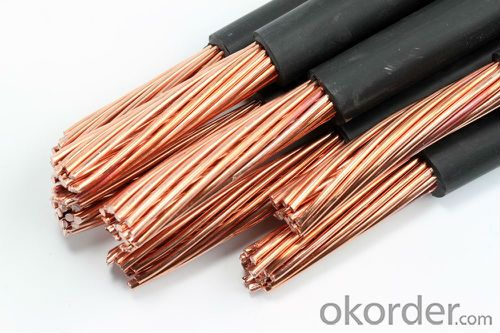

- Q: All the DIY info shows how to change a light fixture. What do you do with the wiring if you want to remove a chandelier, but not replace it with another?I want to make sure the wires in the ceiling are not capable of starting a fire. This is in the first floor of a two-story.
- TURN CIRCUIT OFF.GET A LADDER,SCREW DRIVERS,WIRE NUTS,ELECTRICAL TAPE,COVER PLATE FOR THE HOLE OR YOU CANREFILL HOLE.UNSCREW CHANDELIER, USING SNIPS CUT WIRES,PUT WIRE NUTS OR EACH INDIVIDUAL WIRE,THEN TAPE EACH SEPERATE BUT TOGETHER SO IF NEEDED AGAIN.OR GO TO THE WALL SWITCH.UNSCREW PLATE,TAPE WIRES SEPERATE THEN BIND TOGETHER,IF YOU ARE GOING TO REPLACE CHANDELIER WITH ANOTHER LIGHT INSTALL LIGHT ON CHANDELIER END
- Q: I have a wire heating up and wanting to burn that is going to the alternator (stator) . It is a black wire with a diode on it I think. I went to the john deere dealer and they first gave me a stator because they said that might be problem. It wasnt because i put new stator on and still same result. I took stator back.they checked old one and said it was good.rigged up some diode to put on it. I tried that and still wire wanting to burn up. I think maybe they give wrong diode? I have it figured out it can be only 2 things as all other wires have no shorts and this wire running from the stator is black, connects to a 4 prong plastic connector where it changes to red and goes to the solenoid, Is this wire suppose to be a hot wire where it connects to the plastic connector? I have photos of exactly what I am talking about if someone can help me I can send them the photos. It is in great detail taken with digital camera.
- if it starts to heat up which means you have a high resistance somewhere -- the diode is used to make sure the flow of power goes in one direction check the diode and make sure it is pointing the right way
- Q: 1 phase partial HP motor does the cap get wired to the line side of the circuit? I got a junk motor and table saw that was wired with a 2 conductor cable and the line/neutral was a maybe. When I replaced the cable and cleaned the start switch it now trips the breaker. I then reversed the line/ n connections and it hums but does not start. I cleaned the dust and have read to ground for a clean insulation. After 50 some years in the electrical industry, I now need to wire some motors internally rather than send 'em to the shop for a rewind. Thanks guys.
- Many okorder
- Q: Yuba wire yellow and green one, blue one brown one, different fire line zero line
- The video cable connecting the computer and the projector is called the VideoGraphicsArray, and the audio cable connected to the projector can be directly translated: Theaudioline
- Q: I have a electrical wire to my ceiling light. The electrical outlet does not have an on/off switch so i want to put a switch on the wire next to my couch. I dont want a switch on the outlet since its not easily accessible. Is there a switch that can splice the two ends.
- You can get an extension cord with a switch on it. Another option is a wireless switch. I got one from Target for like $25, it has two independent switches so that you can switch two lights with a little remote control. Wait is your electrical wire inside the wall or plugged into an outlet?
- Q: I had a space heater on in a bedroom. I know, dumb idea, but it was plugged in to a power strip, which was plugged into a standard outlet. It was on for about 30 minutes. Then, it just shut off. I thought nothing of it, but when i unplugged the heater and later tried to plug other things into the power strip, the light on the power strip was on (the one that is always on if the strip is getting power), but nothing plugged in would work, even after resetting it. My house s circuit breaker did not trip. After unplugging the power strip, the outlet still works if I plug somethig in. This is probably insanely paranoid of me, but could this cause damage to my home s electrical wiring? Could this cause an electrical fire after everything has been unplugged?Thank you.
- Yes space heaters can. it isn't common but may be possible. Surge protectors aren't extention cords they are a device to protect electronic devices from an electrical over charge or surge. So under high wattage use will fry the electrical connections in the protector. That's probably what happened here. Other times they can catch fire and maybe a small explosion. The largest electric space heaters are around 1500w and draw about 12 amps. Most home outlets are rated at 15A or even 20A. So in good working order most heaters won't hurt an outlet or wiring if that is the only thing on that breaker. If things do go higher the breaker should trip and cut power. If the breaker is old or damaged it may not trip and then somethings gotta give next either the outlet or the wiring normally it's the plug but if two things on two plugs the wire may catch fire. also don't use cheap extention cords they will catch fire you can use extention cords but rated at least 14G for 15A or 12G for 20A.
- Q: hope you can help
- pure iron cannot be used since highly pure iron has low strength of 150 mega pascals.steel can be used in car bodies (plain steel is an alloy of iron and carbon). Steel with low Carbon content (ex: mild steel) is used and alloy steels can also be used. it has to be ductile and high fracture toughness. Good tensile strength is needed. For the copper to be used as electrical wires it has to be 99.7% pure. After copper is drawn to thin wires, it looser conductivity so it has to annealed to get back conductivity.
- Q: I have a picture of them on my phone. 2 wires are green. The last wire is orange. I couldn't post the pic but I have a pic of it on my cell phone. Thank You, Chris 1986 350 boat engine
- I'll GUESS that they *may* be the two positive 12VAC outputs from alternator, and common negative (ground)which would be hooked up to a bridge rectifier, to give you 12VDC.
- Q: I can hear a small rodent within the walls of my bathroom. Now the power in my bathroom and bedroom is off. Could that rodent have eaten away at the wiring and caused the power to be off?
- Of course they can. All rodents use their teeth to chew through any number of things. This can be a common cause of house fires and electrical failures. Either trap those mother ******* or bring in a specialist. Peanut butter on a mouse trap works well word of advice: if you see/hear one mouse you will definitely have more than one. More like 10. Happy hunting!
- Q: I live in a rental townhome with three other houses connected. I believe they were built in the 50's if that matters. These are breakers with copper wiring and I noticed the other day just how crazy our electrical is run. First we only have four 15 amp breakers, one of them dedicated to our washer and entire kitchen including our fridge and microwave, and the window receptacle we would plug our window ac in to! The dryer has a dedicated 50 amp but the entire house runs off of those four 15 amp breakers. We recently bought a second fridge and i wanted to plug it in next to our washer but now that i know what is all running off that line i dont know what to do. I know this couldn't meet code in a home but is there some loophole rental units get away with doing this!? Would it be safe to plug my second fridge into that line?
- For a home that was built in the 1950s, that was the standard. The loophole is a grandfather clause that permits properties to be up to standard when they were built.
Send your message to us
Bcopper PVC Electrical Wire
- Loading Port:
- China Main Port
- Payment Terms:
- TT or LC
- Min Order Qty:
- -
- Supply Capability:
- -
OKorder Service Pledge
OKorder Financial Service
Similar products
Hot products
Hot Searches
Related keywords
